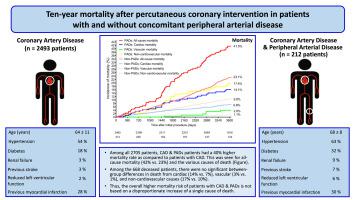当前位置:
X-MOL 学术
›
Atherosclerosis
›
论文详情
Our official English website, www.x-mol.net, welcomes your feedback! (Note: you will need to create a separate account there.)
Ten-year mortality after treating obstructive coronary atherosclerosis with contemporary stents in patients with or without concomitant peripheral arterial disease
Atherosclerosis ( IF 5.3 ) Pub Date : 2024-03-26 , DOI: 10.1016/j.atherosclerosis.2024.117488 Tineke H. Pinxterhuis , Eline H. Ploumen , Daphne van Vliet , K. Gert van Houwelingen , Martin G. Stoel , Frits HAF. de Man , Marc Hartmann , Paolo Zocca , Gerard CM. Linssen , Robert H. Geelkerken , Carine JM. Doggen , Clemens von Birgelen
Atherosclerosis ( IF 5.3 ) Pub Date : 2024-03-26 , DOI: 10.1016/j.atherosclerosis.2024.117488 Tineke H. Pinxterhuis , Eline H. Ploumen , Daphne van Vliet , K. Gert van Houwelingen , Martin G. Stoel , Frits HAF. de Man , Marc Hartmann , Paolo Zocca , Gerard CM. Linssen , Robert H. Geelkerken , Carine JM. Doggen , Clemens von Birgelen

|
Previous studies in percutaneous coronary intervention (PCI) patients showed a higher 3-year adverse event risk, including all-cause mortality, in those with concomitant peripheral arterial disease (PADs). Ten-year data of mortality and causes of death are scarce. This analysis assessed PCI patients, treated with contemporary drug-eluting stents, the impact of concomitant PADs on very long-term mortality, and causes of death. We assessed PCI all-comers from our center who participated in the TWENTE and DUTCH PEERS trials (, ), comparing patients with without PADs. Life status was checked in the Dutch Personal Records Database; causes of death were obtained from medical records. Of 2705 study patients, 668 (24.7%) died during follow-up: 88/212 (41.5%) patients with PADs and 580/2493 (23.1%) without PADs. In PADs patients, the 10-year rate of all-cause mortality was about twice as high as in patients without PADs (41.5% 23.1%, HR: 2.05, 95%-CI: 1.64–2.57, 0.001). For both groups, the rates of patients dying from various causes of death were: cardiac (14.1% 6.8%), vascular (2.8% 1.1%), non-cardiovascular (17.4% 9.8%), and unclear causes (7.1% 5.3%), without a statistically significant between-group difference. When multivariate analysis was adjusted for between-group differences in cardiovascular risk profile, PADs remained predictor of all-cause mortality (adjusted HR: 1.38, 95%-CI: 1.08–1.75, 0.01). The 10-year all-cause mortality rate in PCI patients with concomitant PADs was almost twice as high as in those without PADs. Age and other traditional cardiovascular risk factors were higher in patients with PADs, but after correction for these confounders PADs still accounted for almost 40% increase in mortality.
中文翻译:

患有或不伴有外周动脉疾病的患者使用现代支架治疗阻塞性冠状动脉粥样硬化后十年死亡率
先前对经皮冠状动脉介入治疗 (PCI) 患者的研究表明,伴有外周动脉疾病 (PAD) 的患者 3 年不良事件风险较高,包括全因死亡率。十年来的死亡率和死因数据很少。该分析评估了接受现代药物洗脱支架治疗的 PCI 患者、同时使用 PAD 对长期死亡率的影响以及死亡原因。我们评估了我们中心参加 TWENTE 和 DUTCH PEERS 试验 (, ) 的所有 PCI 患者,比较了没有 PAD 的患者。在荷兰个人记录数据库中检查了生活状况;死亡原因是从医疗记录中获得的。在 2705 名研究患者中,668 名(24.7%)在随访期间死亡:88/212(41.5%)名患有 PAD 的患者,580/2493(23.1%)名没有 PAD 的患者。 PAD 患者的 10 年全因死亡率约为无 PAD 患者的两倍(41.5% 23.1%,HR:2.05,95%-CI:1.64–2.57,0.001)。两组患者死于各种死因的比例分别为:心脏疾病(14.1% 6.8%)、血管疾病(2.8% 1.1%)、非心血管疾病(17.4% 9.8%)和不明原因死亡(7.1% 5.3%) ),组间无统计学显着差异。当根据心血管风险状况的组间差异调整多变量分析时,PAD 仍然是全因死亡率的预测因子(调整后的 HR:1.38,95%-CI:1.08-1.75,0.01)。合并 PAD 的 PCI 患者 10 年全因死亡率几乎是未合并 PAD 患者的两倍。 PAD 患者的年龄和其他传统心血管危险因素较高,但校正这些混杂因素后,PAD 仍占死亡率增加的近 40%。
更新日期:2024-03-26
中文翻译:

患有或不伴有外周动脉疾病的患者使用现代支架治疗阻塞性冠状动脉粥样硬化后十年死亡率
先前对经皮冠状动脉介入治疗 (PCI) 患者的研究表明,伴有外周动脉疾病 (PAD) 的患者 3 年不良事件风险较高,包括全因死亡率。十年来的死亡率和死因数据很少。该分析评估了接受现代药物洗脱支架治疗的 PCI 患者、同时使用 PAD 对长期死亡率的影响以及死亡原因。我们评估了我们中心参加 TWENTE 和 DUTCH PEERS 试验 (, ) 的所有 PCI 患者,比较了没有 PAD 的患者。在荷兰个人记录数据库中检查了生活状况;死亡原因是从医疗记录中获得的。在 2705 名研究患者中,668 名(24.7%)在随访期间死亡:88/212(41.5%)名患有 PAD 的患者,580/2493(23.1%)名没有 PAD 的患者。 PAD 患者的 10 年全因死亡率约为无 PAD 患者的两倍(41.5% 23.1%,HR:2.05,95%-CI:1.64–2.57,0.001)。两组患者死于各种死因的比例分别为:心脏疾病(14.1% 6.8%)、血管疾病(2.8% 1.1%)、非心血管疾病(17.4% 9.8%)和不明原因死亡(7.1% 5.3%) ),组间无统计学显着差异。当根据心血管风险状况的组间差异调整多变量分析时,PAD 仍然是全因死亡率的预测因子(调整后的 HR:1.38,95%-CI:1.08-1.75,0.01)。合并 PAD 的 PCI 患者 10 年全因死亡率几乎是未合并 PAD 患者的两倍。 PAD 患者的年龄和其他传统心血管危险因素较高,但校正这些混杂因素后,PAD 仍占死亡率增加的近 40%。



























 京公网安备 11010802027423号
京公网安备 11010802027423号